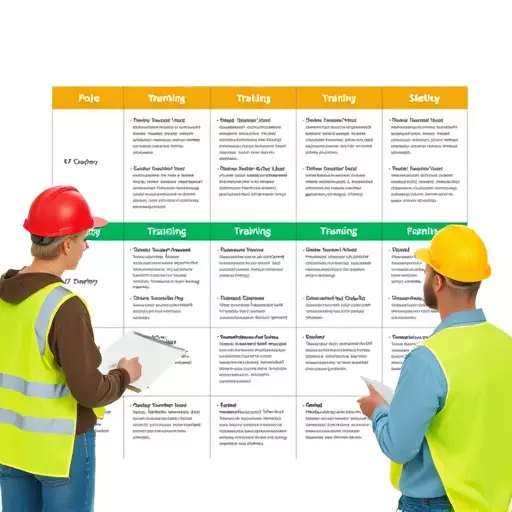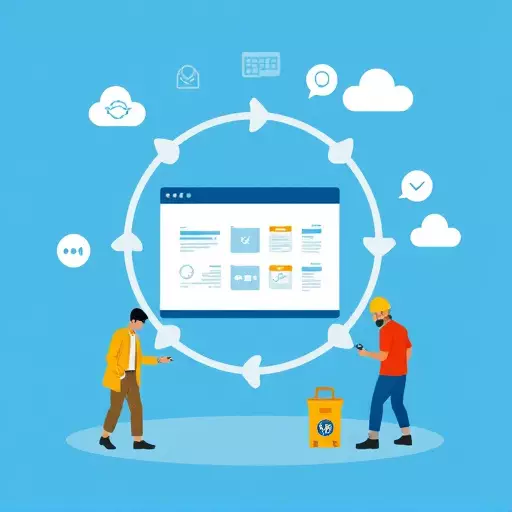Environmental Health and Safety (EHS) training is crucial for creating safe workplaces, involving hazard identification, regulatory understanding, and tailored business-specific training. With diverse industry risks, effective EHS training includes areas like chemical handling, ergonomics, and infection control. Compliance training scheduling tools simplify tracking, reminders, and keeping up with regulatory changes. In the digital era, strategic planning is key; a structured framework guides businesses through goal setting and resource allocation for critical EHS areas. Stakeholder identification, tailored training to diverse learning styles, and efficient scheduling tools streamline processes. Creating robust occupational safety training programs, updated with evolving regulations, fosters a culture of safety and ensures legal compliance. Advanced scheduling tools provide centralized platforms for attendance tracking, content management, and real-time data insights. Strategic budgeting considers direct costs (instructor fees, materials) and indirect costs (technology, employee time). Prioritizing essential topics, engaging expert trainers, and regularly reviewing budgets optimize EHS training quality.
Effective Environmental Health and Safety (EHS) training is crucial for any organization aiming to create a safe work environment. This article guides you through strategic EHS training budget planning, ensuring your safety efforts are well-resourced. We explore essential components: understanding regulatory requirements, developing a structured training plan, identifying diverse stakeholder needs, designing impactful occupational safety programs, and leveraging compliance training scheduling tools for optimal management. By the end, you’ll be equipped to allocate resources efficiently for successful EHS training implementation.
- Understanding Environmental Health and Safety (EHS) Training Requirements
- Developing a Comprehensive EHS Training Planning Framework
- Identifying Key Stakeholders and Their Training Needs
- Creating Effective Occupational Safety Training Programs
- Implementing Compliance Training Scheduling Tools for Efficient Management
- Budgeting and Allocating Resources for Successful EHS Training Implementation
Understanding Environmental Health and Safety (EHS) Training Requirements

Environmental Health and Safety (EHS) training is a critical component of any organization’s commitment to maintaining a safe work environment. Understanding the specific requirements for EHS training involves identifying potential hazards within the workplace, assessing regulatory obligations, and aligning training with the unique needs of the business. Effective EHS training planning encompasses more than just compliance; it aims to empower employees with the knowledge and skills to recognize and mitigate risks, ultimately fostering a culture of safety.
Occupational safety training programs vary based on industry, facility operations, and potential risks. From chemical handling and emergency response to ergonomics and infection control, the scope of EHS topics is vast. Utilizing compliance training scheduling tools can streamline the planning process by allowing organizations to track employee completion, set reminders, and stay updated with changing regulations. These tools ensure that all staff receive necessary training, promoting a safer and more compliant work environment.
Developing a Comprehensive EHS Training Planning Framework

In today’s digital era, effective Environmental Health and Safety (EHS) training budget planning is a game-changer for any organization committed to ensuring workplace safety and compliance. A well-structured EHS training planning framework is essential, acting as a compass guiding businesses through the labyrinthine process of identifying critical areas, setting realistic goals, and allocating resources efficiently. This involves assessing existing safety protocols, gauging employee knowledge levels, and pinpointing specific regulatory requirements relevant to their industry.
Utilizing compliance training scheduling tools can significantly enhance this planning process. These tools enable professionals to streamline scheduling, track attendance, and measure the effectiveness of various occupational safety training programs. By integrating such technology into EHS training budget planning, organizations can ensure they are not only meeting legal obligations but also fostering a culture of safety and empowerment among their workforce.
Identifying Key Stakeholders and Their Training Needs

Identifying key stakeholders is a crucial step in effective EHS training budget planning. These individuals or groups within an organization are directly impacted by environmental health and safety practices. Their unique roles and responsibilities dictate their specific training needs. For instance, managers require comprehensive oversight and compliance training to ensure adherence to regulations, while employees need hands-on skill development for hazardous material handling or emergency response procedures.
Occupational safety training programs should be tailored to cater to diverse learning styles and job functions. Utilizing compliance training scheduling tools can streamline the process, enabling efficient allocation of resources and ensuring that all stakeholders receive necessary EHS training within set timelines. This strategic approach optimizes budget utilization while fostering a culture of safety and regulatory compliance across the organization.
Creating Effective Occupational Safety Training Programs

Creating effective occupational safety training programmes is a cornerstone of any robust environmental health and safety training planning. These programmes should be tailored to address specific workplace hazards, ensuring that employees receive relevant and up-to-date information. Utilizing compliance training scheduling tools can streamline this process by facilitating the identification of training gaps, setting schedules, and tracking employee completion rates.
By integrating these tools into your EHS training budget planning, you can enhance efficiency, ensure consistent worker education, and foster a culture of safety. Regularly updating training curricula to align with evolving regulations and industry best practices is essential, allowing organisations to stay compliant and protect their workforce and environment.
Implementing Compliance Training Scheduling Tools for Efficient Management

In the realm of environmental health and safety (EHS) training budget planning, implementing compliance training scheduling tools is a game-changer for efficient management. These tools streamline the process of organizing and delivering occupational safety training programs by offering centralized platforms to track attendance, manage content, and set reminders. By leveraging technology, organizations can ensure that all employees receive up-to-date information on crucial safety protocols in a timely manner.
Compliance training scheduling tools also facilitate personalized learning paths, enabling folks to access relevant resources based on their roles and responsibilities. This tailored approach enhances knowledge retention and fosters a culture of continuous improvement within the organization. In today’s digital era, these tools not only enhance but also revolutionize EHS training planning by providing real-time data insights, allowing professionals to promptly adapt programs as needed.
Budgeting and Allocating Resources for Successful EHS Training Implementation

Effective Environmental Health and Safety (EHS) training implementation requires strategic budgeting and resource allocation. Organizations should first assess their existing EHS program, identify training gaps, and define clear objectives for improvement. This involves understanding regulatory requirements and industry best practices to tailor compliance training programs accordingly. Utilizing advanced scheduling tools can streamline the process, enabling efficient planning and delivery of occupational safety training across various departments and locations.
Resource allocation should consider both direct and indirect costs, including instructor fees, course materials, technology infrastructure, and time spent by employees in training. Prioritizing essential topics like hazard communication, emergency preparedness, and specific regulatory compliance can optimize the budget. Additionally, engaging experienced trainers and utilizing interactive, engaging formats for delivery can enhance learning outcomes while keeping costs manageable. Regularly reviewing and updating budgets is crucial to adapt to changing needs and ensure sustained EHS training quality.


